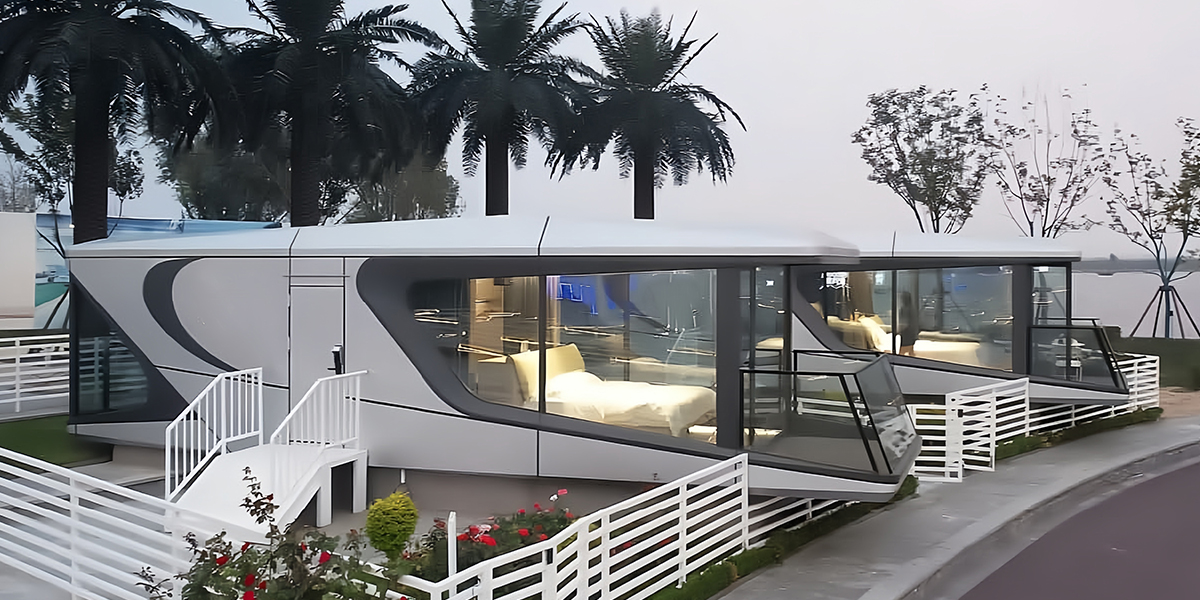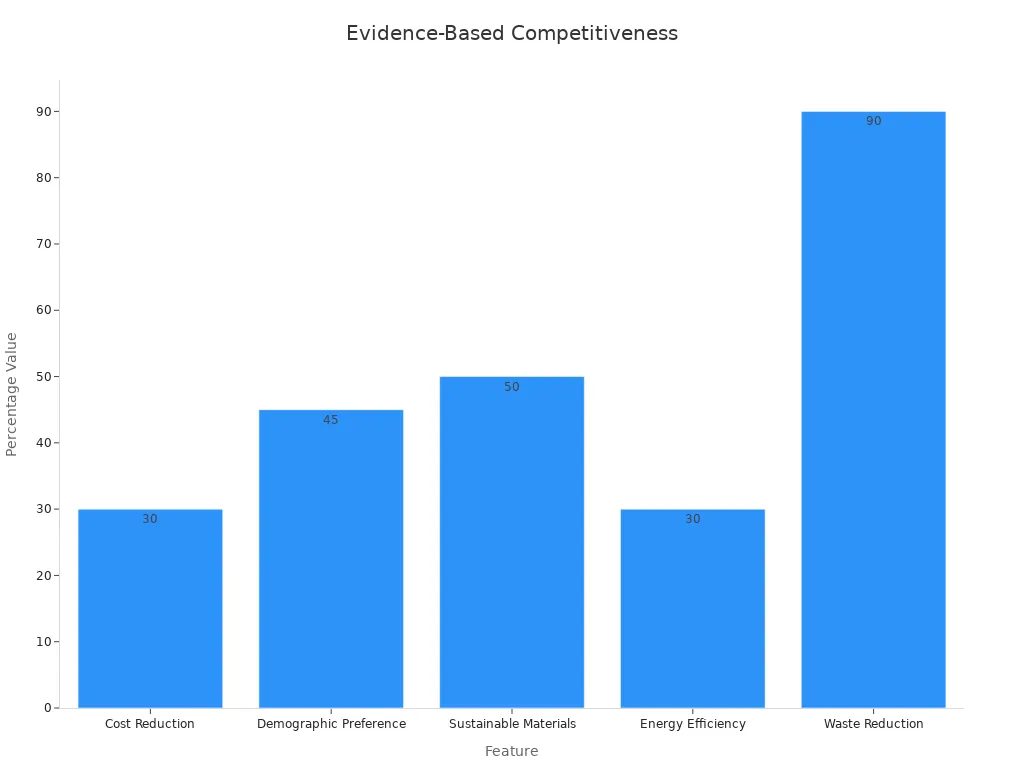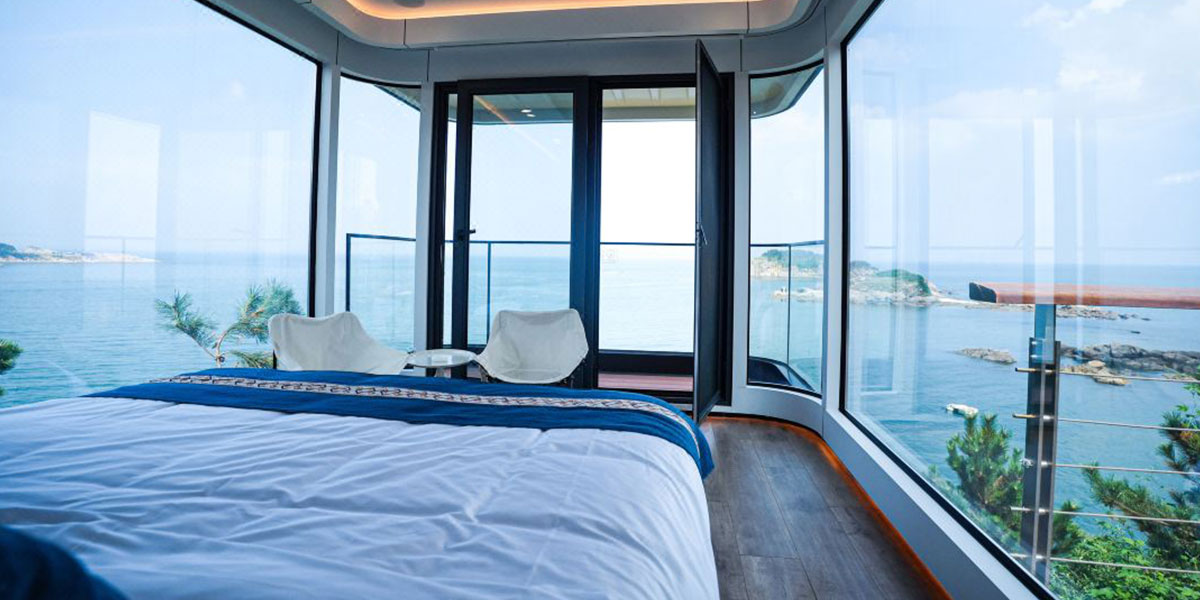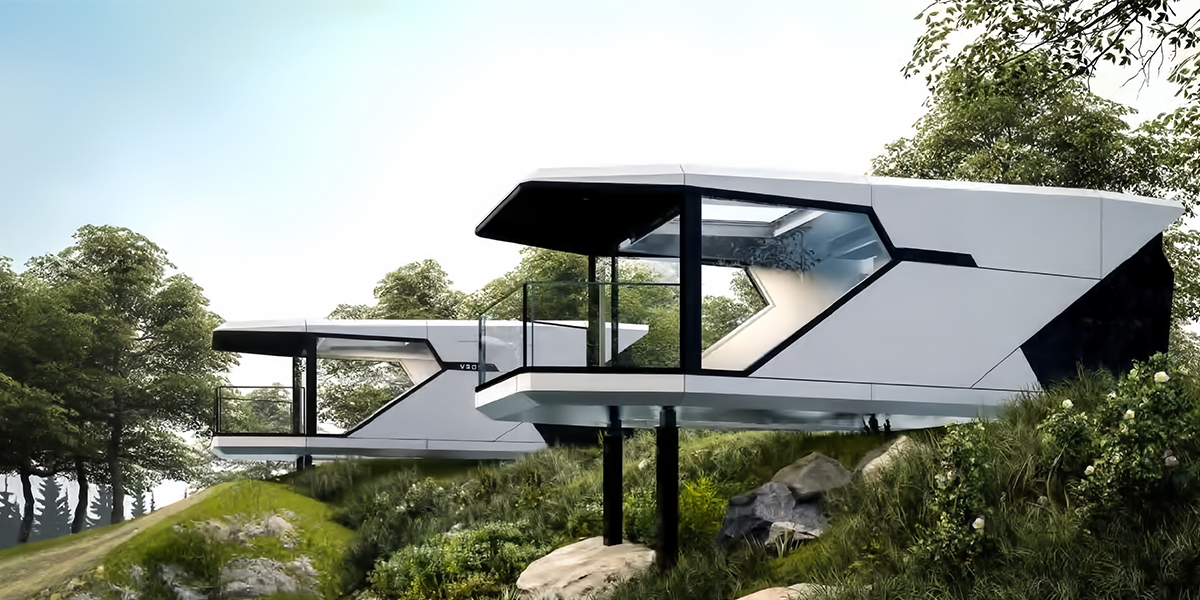
11 Jul A Comprehensive Review of the Best Capsule Houses for Modern Living
Table of Contents
Capsule houses are now a top choice for homes in 2025. Sleadgroup Capsule House, The Genesis by Dragon Tiny Homes, and Double-Deck Space Capsule Home are popular. They use space well, cost less, and help the environment. More people in cities want them, especially millennials and Gen Z. Capsule houses and micro homes can cost as little as $20,000. This new way of living matches future trends in capsule homes. Cities are growing, and people care more about the planet. Cities think capsule houses can help with future housing needs.
Key Takeaways
Capsule houses help save space and money. They are good for the environment. This makes them great for cities that are growing. Different capsule models work for different people. Some are good for eco-friendly city life. Others are for tech lovers or families. Smart designs use foldable furniture. They also have built-in storage. This makes small spaces comfy and useful. Capsule homes are fast to build. They are easy to move. They use recycled materials. This helps cut down waste and energy use. Before you buy, check local rules. Think about your budget and space needs. Look at the warranty. This helps you pick the best capsule home.
Best Capsule Houses 2025
Sleadgroup Capsule House
Sleadgroup Capsule House is special in 2025. It uses green building ideas and smart engineering. The house is made with recycled steel and old wood. It also uses concrete that is better for the planet. This helps cut carbon pollution by half. Solar panels and thick windows help save energy. People can pay up to 30% less on their energy bills. The house is built in a factory, so less trash is made. This method cuts waste by almost all of it. The small size, from 100 to 300 square feet, fits well in crowded cities. Every bit of space is used well. There are beds that fold up and furniture built into the walls. People can live comfortably and still have room to move. The house is easy to move to new places. This is good for people who work from home or move a lot. Sleadgroup Capsule House is not too expensive. It is a good choice for people who want a modern home that is also good for the earth.
Note: Capsule houses like Sleadgroup’s model help cities use space better and stop cities from spreading out too much.
Feature | Details |
|---|---|
Eco-Friendly Materials | Recycled steel, reclaimed wood, low-impact concrete (50% less emissions) |
Energy Efficiency | Solar panels, double-glazed windows (up to 30% energy savings) |
Waste Reduction | Prefabrication reduces waste by 90% |
Affordability | Lower construction and labor costs |
Space Optimization | Built-in furniture, foldable beds, smart layouts |
Urban Suitability | Compact design for city living |

The Genesis by Dragon Tiny Homes
The Genesis by Dragon Tiny Homes mixes comfort, moving, and smart design. This capsule home is 16 feet long. It has 135 square feet of space and a loft for a queen bed. The stairs are new and have storage inside. They are easier to use than a ladder. The kitchen has quartz counters, a two-burner cooktop, and a steel sink. There is a big fridge and a spot for laundry. The bathroom has a shower, toilet, and a small sink. The outside is made with strong wood and cement siding. This keeps the house safe in any weather. The house is NOAH certified, so it is safe and high quality. The Genesis weighs about 10,000 pounds. You can move it with a big truck like an F250. This makes it great for people who want to travel. The price starts at $39,500. It is good for living all the time or as a vacation home.
Feature | Specification/Detail |
|---|---|
Length | 16 feet |
Living Area | 135 sq ft + loft for queen bed |
Weight | Approx. 10,000 lbs |
Kitchen | Quartz countertops, induction cooktop, stainless sink |
Laundry | Combination washer/dryer unit |
Bathroom | 36-inch shower, flush toilet, small sink |
Climate Control | Mini-split system |
Exterior | Engineered wood, cement-based siding |
Certification | NOAH-certified |
Mobility | Towable by F250 or similar vehicle |
Price | Starting at $39,500 |
Double-Deck Space Capsule Home
Double-Deck Space Capsule Home gives more space in a small area. It has two floors stacked on top of each other. This means you get twice the room without using more land. The bottom floor has a living room, kitchen, and bathroom. The top floor is for sleeping or working. You can change the layout to fit your needs. The house is built to keep heat in and block noise. It is safe in strong winds and big earthquakes. The house can handle wind up to 70 meters per second. It can also stand earthquakes up to a 9. The systems save energy and keep the air cool. Lights are bright and placed all over the house. Double-Deck Space Capsule Home is good for families and workers. It gives more space but stays small and not too costly.
Metric | E-Series Capsule House | T-Series Capsule House |
|---|---|---|
Dimensions | 10.5 ft wide/tall; 7 ft 10.5 in height | Same dimensions |
Durability | Lifespan over 50 years | Same durability |
Wind Resistance | Up to 70 m/s (Level 12) | Same wind resistance |
Earthquake Resistance | Magnitude up to 9 | Same earthquake resistance |
Sound Insulation | Noise reduction ≥ 55 dB | Same sound insulation |
Thermal Insulation | 3.2 m²·K/W (6x traditional) | Same thermal insulation |
Air Tightness | n50 = 0.45 | Same air tightness |
Fire Resistance | Grade A (structure/exterior), B1+ (interior) | Same fire resistance |
Energy Efficiency | ~65% more efficient than traditional | Same energy efficiency |
Glass Coverage | Windows on 2 sides | Windows on 3 sides |
Lighting | Standard lighting | More comprehensive lighting |
Balcony Models | None | Available (T30, T40, T40P) |
AC Units | Wall-mounted split units | Concealed vents for AC |
Sci-Fi Capsule Home
Sci-Fi Capsule Home looks like it is from the future. It uses smart technology and cool designs. The outside has smooth lines and new materials. This makes it look modern and different. Inside, you can control lights with your voice. There are health tools and solar glass to save power. The space is used well with hidden storage and furniture that does more than one thing. The house keeps heat in and blocks noise. This makes it quiet and comfy. Solar panels and energy-saving systems help the planet. Sci-Fi Capsule Home is great for people who love new tech. It is a small home that feels high-tech and does not cost too much.
Tip: Sci-Fi Capsule Home’s smart features are perfect for people who want the newest technology in their home.
Capsule House Features
Capsule homes are a top choice for city living. They are small but use space in smart ways. These homes have layouts that save space, are built in parts, and help the planet. More people want capsule homes in 2025 because cities are getting bigger and space is tight.
are a top choice for city living. They are small but use space in smart ways. These homes have layouts that save space, are built in parts, and help the planet. More people want capsule homes in 2025 because cities are getting bigger and space is tight.
Feature Category | Key Statistics / Details |
|---|---|
Urbanization | Over 55% of people live in cities now. By 2050, this will be 68%. |
Cost Reduction | Micro-housing can lower housing costs by about 30%. |
Water Conservation | Green features cut water use by 30-50%. |
Space Utilization | Capsule houses are 100 to 300 square feet. This saves space in cities. |
Demographic Preference | 45% of millennials want smaller homes with less work. |
Mobility | Capsule homes are easy to move, so people have choices. |
Installation Speed | They are quick to build and ready to use fast. |
Space Efficiency | Smart designs like foldable beds help save space. |
Sustainability | Using recycled materials cuts carbon by half. Energy use is 65% less than normal homes. |
Smart Technology | Smart thermostats and energy systems help stop waste. |
Affordability | Monthly costs are $229 to $800. This is much less than regular apartments at $1,200+. |
Space Efficiency
Capsule homes make good use of every bit of space. Designers add beds that fold up, storage in walls, and furniture that does more than one thing. People can live well in just 100 square feet. This makes capsule homes great for busy cities. Many people pick capsule homes to have less stuff and focus on what matters.
Modularity and Customization
Capsule homes are built in sections that you can change. Owners can add or take away rooms as needed. For example, a family can add a bedroom or a work area. You can pick different layouts, colors, and materials. This means each home fits the owner’s style. Being able to change the home makes people happy for a long time.
Privacy and Comfort
Privacy is still important in small homes. Capsule homes use smart layouts to keep sleeping, living, and work areas apart. Thick walls and special windows keep out noise. Many have systems to control the temperature all year. These things make the home quiet and private, even in busy places.
Innovative Features
New ideas make capsule homes more popular. Many now have solar glass, smart thermostats, and energy-saving systems. The market for solar glass is growing fast. It could be worth $136.69 billion by 2032 and grow by 30.2% each year. These tools help save energy and lower bills. Capsule homes often use recycled materials and better insulation. This helps the planet and makes homes greener.
Note: Capsule homes cost less, are faster to set up, and are better for the environment.
Capsule Homes Comparison
Sustainability
Capsule homes are great for the environment. Builders use wood and recycled steel. These materials help save resources and lower pollution. A study showed tiny houses made from wind turbine parts are better for the planet. When a capsule home is old, energy can be reused. Tools like Edge App and SimaPro help check how green these homes are. Monolithic capsule homes are best for net-zero carbon buildings. This makes them good for cities that want to be greener. Tinplate designs make recycling easier in cities. As steel gets cleaner to make, capsule homes will help the earth even more.
Capsule Home Type | Biobased Materials | Lifecycle Energy Use | Sustainability Index | Circularity Score |
|---|---|---|---|---|
Sleadgroup Capsule House | Yes | Low | High | 0.97 |
Genesis by Dragon Tiny | Yes | Moderate | Moderate | 0.80 |
Double-Deck Capsule | Yes | Low | High | 0.97 |
Sci-Fi Capsule Home | Mixed | Low | High | 0.97 |
Affordability
Capsule homes are a cheaper way to live today. You can pick from fancy, normal, or budget models. Budget capsule homes give you what you need for less money. People want these homes because city prices are high. Capsule homes cost less than regular houses. This helps people who cannot buy big homes. Smart and green features make them better without costing more. Young people and travelers like small, affordable homes. This helps cities grow in a smart way.
- Capsule homes usually cost less than regular homes.
- High rents and money problems make people want cheaper homes.
- Smart features make homes better but still low-cost.
Space Optimization
Capsule homes use space in smart ways. Designers add shelves, fold-up beds, and rooms that do more than one thing. These homes are 300 to 500 square feet. They still feel roomy and nice. Each square foot costs about $150, which is less than normal homes. Capsule homes work well in cities and for emergency shelters. They keep people warm even when it is very cold outside. More people want capsule homes because they save space and help the planet.
Aspect | Capsule Homes Metric | Traditional Homes Metric |
|---|---|---|
Space Size | 300–500 sq ft, smart layouts | 1,000+ sq ft |
Cost per Sq Ft | $150 | $175 |
Insulation | Maintains 16°C at -15°C outside | Varies |
Market Growth | 7.4% CAGR (2024–2029) | Lower |
Technology
Capsule homes use new technology to be strong and safe. Builders use steel, aluminum, fiberglass, and carbon fiber. These materials last a long time. Homes are built in factories, so they go up fast and make less trash. Capsule homes have insulation, smart thermostats, and energy-saving appliances. Fire safety tools and special materials keep people safe. Modular designs let you move or change the home easily. Furniture does more than one job to save space. Capsule homes are made to last and need little fixing. All these things help the planet and save money.
- Strong materials make homes last longer.
- Factory building saves time and cuts waste.
- Smart systems use less energy and lower bills.
Customization
Capsule homes can be changed to fit your style. You can pick how the inside and outside look. Layouts can change for families, singles, or people who work from home. You can add or take away rooms with modular designs. Buyers choose colors, materials, and extras like solar panels or green roofs. 3D design tools show what changes will look like before building. Customizing makes capsule homes useful and fun for everyone. This helps cities grow in a smart and green way.
Pick layouts for different needs.
Add things like solar panels or decks.
Pros and Cons
 Sleadgroup Capsule House
Sleadgroup Capsule House
Sleadgroup Capsule House is known for being green and saving money. Experts like that it uses recycled things and solar panels. The small design helps people use less energy and live simply. This model is good for crowded cities and helps them grow in a green way. But, some people say the space feels small, especially for families. Thin walls can make it hard to have privacy. Sometimes, city rules make it tough to put these homes in some places.
Advantages | Drawbacks |
|---|---|
Not much living space | |
Easy to move and use | Privacy can be a problem |
Uses green materials | Hard to follow some rules |
Good for simple living | Not comfy for everyone |
Works well in cities | May not sell for much later |
Note: Sleadgroup Capsule House is best for people who want to live simply and help the planet.
The Genesis by Dragon Tiny Homes
The Genesis by Dragon Tiny Homes gives comfort and is easy to move. Owners like the smart storage in the stairs and the bed in the loft. The kitchen and bathroom have nice things. You can move this home, so travelers like it. But, the living space is still small. Some people think the open plan means less privacy. Local laws can also make it hard to put these homes anywhere.
Pros:
- Smart places to store things
- Nice finishes in the home
- Simple to move to new spots
- Good for one or two people
Cons:
- Living area is small
- Not much privacy
- Some places have rules against it
Double-Deck Space Capsule Home
Double-Deck Space Capsule Home has two floors for more room. Families and people who work from home like the extra space. The strong build keeps people safe from wind and earthquakes. Energy-saving tools help lower bills. But, not everyone likes the stairs. Stairs can be hard for older people or little kids. Some say the home feels less open than other capsule homes.
Pros:
- More space with two floors
- Strong and safe to live in
- Keeps heat in and saves energy
Cons:
- Stairs are hard for some people
- Feels less open inside
- Still smaller than regular houses
Sci-Fi Capsule Home
Sci-Fi Capsule Home is great for people who love new tech. Voice controls and solar glass make life easier. The design uses all the space for storage and comfort. These homes save energy and are quiet. But, not everyone likes the future look. Some people say the tech is hard to fix. The small size means less room for things to do or store.
Pros:
- Has cool new technology
- Uses less energy
- Looks modern and different
Cons:
- Tech can be hard to fix
- Not much space for stuff
- Not good for big families
Tip: Capsule homes are smart, cheap, and easy to move, but people should think about space, privacy, and local rules before buying.
Practical Considerations
Regulations and Zoning
Capsule homes have to follow many rules in American cities. Local leaders often do not allow them in regular neighborhoods. Many places have rules about how big a house must be and how land is used. These rules can stop capsule homes from being built in some areas. Builders sometimes have trouble getting permission because capsule homes do not always fit the old building rules. These problems can slow down building and make it cost more. This makes it harder for people to find cheap homes. Before buying, people should talk to city workers to learn about where they can put a capsule home and what rules they must follow.
Tip: Always look at city and county rules before buying a capsule home so you do not get any expensive surprises.
Durability and Maintenance
Capsule homes are made to last a long time. Most modular homes come with a warranty for problems with parts or how they are built. These warranties can last from 1 to 10 years. The main parts of the house often have longer coverage. Companies help owners with questions about putting the home together and taking care of it. Homeowners get tips for keeping their home in good shape. If something breaks, repair help and new parts are covered by the warranty. Some companies let owners upgrade or add to their capsule home if they need more space.
Note: Taking care of your capsule home helps it last longer and stay nice to live in.
Real-Life Applications
Capsule homes are used in many ways across the USA. People live in them full-time, use them as vacation cabins, or set them up as backyard offices. Cities use capsule homes to help with not enough places to live. These homes are also good for emergency shelters and student housing. This makes them a smart choice for city living. By helping cities with housing, capsule homes give people more choices that are cheaper and better for the planet.
People use capsule homes for:
- Living all the time if you are single or a couple
- A place to stay during disasters
- Extra rooms for guests or to rent out
- Offices you can move for working from home
Capsule homes are getting more popular because they can be used in many ways and help fix housing problems in cities today.
Choosing Your Capsule House
Lifestyle Fit
Picking the right capsule house depends on what you do every day. Each model is made for a different way of living. The Sleadgroup Capsule House is good for people who care about the earth and like to move often. Genesis by Dragon Tiny Homes is best for people who travel a lot or want a home that can change. Double-Deck Space Capsule Home gives more room, so it works well for small families or people who work from home. Sci-Fi Capsule Home is great for people who love new technology and want a home that looks cool and modern.
Model | Best For | Key Lifestyle Match |
|---|---|---|
Sleadgroup Capsule House | Urban professionals, minimalists | Green living, frequent relocation |
Genesis by Dragon Tiny Homes | Digital nomads, travelers | Mobility, compact comfort |
Double-Deck Capsule Home | Small families, remote workers | Extra space, home office |
Sci-Fi Capsule Home | Tech lovers, early adopters | Smart home, modern aesthetics |
Tip: Think about how much space you need, how often you move, and which features are most important for your life.
Buyer Checklist
A simple checklist helps buyers pick the best home. Here are the main things to check:
- Budget: Decide how much you can spend, including delivery and setup.
- Location: Make sure you know the local rules and land needs.
- Space Needs: Pick the smallest size and number of rooms you want.
- Mobility: Choose if you want a home that moves or stays in one place.
- Sustainability: Look for homes with green materials and energy-saving parts.
- Customization: Check what layouts and designs you can pick.
- Warranty: See what the warranty covers for the house and its systems.
- Maintenance: Think about how easy it is to take care of the home.
- Technology: Find out what smart features the home has and if they work with your devices.
- Resale Value: Think about if you can sell the home later and if people will want it.
Buyers who use this checklist can feel sure they are making a good choice with their capsule house.
Capsule houses are special in 2025 because they use green materials, can be changed easily, and have smart tech. Sleadgroup Capsule House is good for people who care about the earth and live in cities. Genesis by Dragon Tiny Homes is best for people who like to travel. Double-Deck Space Capsule Home gives more room for families. Sci-Fi Capsule Home is great for people who love new gadgets. These homes keep heat in, use solar panels, and have smart ways to store things. This makes them perfect for city life in the future. People should think about what they need, look at the features, and talk to the makers to learn more.
FAQ
What is the average lifespan of a capsule house?
Capsule houses usually last from 30 to 50 years. Builders use tough materials like steel and strong wood. Taking care of the house helps it last longer. Owners should always follow the care guide from the maker.
Can capsule houses withstand extreme weather?
Capsule houses are built to handle bad weather. They can stand up to strong winds and earthquakes. Many models meet high safety rules. Double-Deck Space Capsule Home can take winds up to 70 meters per second and earthquakes as strong as 9.
Are capsule houses suitable for families?
Small families can live in capsule houses. Double-deck models give extra space for kids or a work area. Buyers should look at the floor plan to make sure there is enough room for everyone.
How long does it take to install a capsule house?
Most capsule houses come already built in a factory. It usually takes one to three days to set them up. The time depends on how ready the land is and if the utilities are set up.
What financing options exist for capsule homes?
Many banks and lenders now give loans for modular and tiny homes. Buyers can also get personal loans or special loans from the makers. Always check and compare rates and terms before picking a loan.




 Sleadgroup Capsule House
Sleadgroup Capsule House